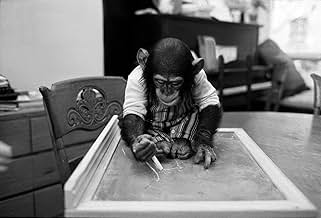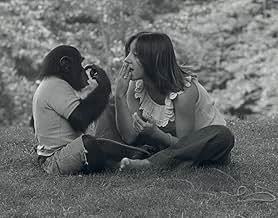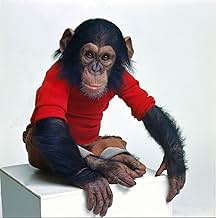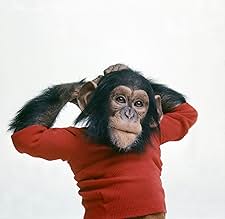Ajouter une intrigue dans votre langueTells the story of a chimpanzee taken from its mother at birth and raised like a human child by a family in a brownstone on the upper West Side in the 1970s.Tells the story of a chimpanzee taken from its mother at birth and raised like a human child by a family in a brownstone on the upper West Side in the 1970s.Tells the story of a chimpanzee taken from its mother at birth and raised like a human child by a family in a brownstone on the upper West Side in the 1970s.
- Nominé pour le prix 1 BAFTA Award
- 16 victoires et 30 nominations au total
- Self
- (archive footage)
- Self
- (archive footage)
- Self
- (as Dr. James Mahoney)
- Self
- (archive footage)
Avis en vedette
The movie is more about a team of people trying to salvage and place an off the track train back on it, when the damage was already done.
The story starts out well, with the impossibly cute baby chimp brought up as a human. Soon, though, the behaviour of some of the "scientists" looking after Nim begins to grate; some of them are a little too involved with their subject, while others are plain creepy. Later, Nim suffers a huge betrayal, and at this point the documentary takes a downward turn into one of the most depressing ever.
Hardly a heartwarming story then, in that it focuses on misery and despair for the majority of the running time, but nevertheless an important story that serves to highlight man's inhumanity towards the world he inhabits.
The chimp's name is taken from Noam Chomsky, the famous MIT linguist. Unfortunately, the linguistic side of this story actually is quite minor compared to what really occurred. Columbia professor Herbert Terrace wanted to conduct an experiment on a baby chimp to see if it could be raised like a human baby and learn to communicate with people. He started the project by snatching the baby from its mother at two weeks of age, and then plopping it right into a large, free-spirited family with no scientific or primate-training background. Heck, no one in the family even knows sign language! The film shows how quickly Nim adapts to the pampered lifestyle and is even breast-fed by Stephanie, the mother. Nim is also exposed to smoking pot, drinking alcohol and even has limited success being potty trained. All of this is explained away with "it was the seventies". I was already bouncing between sadness and anger.
Admittedly, I am no scientist. I do know that a true science experiment or project would involve specific records and at least some type of plan ... not to mention the recording of actions, tests and progress. Instead, Professor Terrace shows up periodically for some photo ops and a hug from Nim. Poof! He is gone again. While this is never really explained in the film, one can only assume he was benefiting nicely from a huge grant, not to mention "close" relationships with a couple of his assistants. The other thing left unexplained was how Nim's mother had other babies taken from her in a similar manner. We get no detail on those "experiments".
As Nim gets older, guess what ... he gets bigger and stronger. He is difficult to control and even lashes out periodically at his caregivers, once quite violently. He is bounced from home to home and person to person. He does adapt, but he is just too strong and unpredictable to be part of human society. Finally, he is sold off to an animal rescue farm. That's just great, except initially there are no other chimps. Not a good thing for a social primate.
The whole thing is just painful to watch. I couldn't help but feel sympathy for the chimp and anger at the people ... especially Professor Terrace. His selfish, ill-conceived project negatively impacted the life of a chimp and the safety and well-being of many good-hearted people along the way.
While there was proof that Nim learned approximately 125 signs, the question remains ... did he really understand these words and phrases? Did he instead learn behavior that led to his reward? One of Nim's later day caregivers (Bob Ingersoll) visited him often at the rescue farm until at the age of 26, Nim passed away. The average lifespan of a chimp in the wild is about 45 years. So, it would appear neither the chimp or the people really benefited from Project Nim. It is, however, a well made documentary.
The very idea of a chimp being brought up in human society is a fascinating one. But it quickly becomes apparent that this experiment is doomed to failure. There is a very good reason that you do not see people keep chimpanzees as pets – they can be extremely aggressive and powerful animals. On numerous occasions carers were bitten and maimed. One woman had a hole ripped in the side of her face while another had her head repeatedly beaten off the pavement by the ape. But the over-riding feeling engendered by the documentary is one of sadness. This poor creature is let down by those who took him from his mother and decided to rear him as a human. It seems to me quite outrageous that an animal taught to communicate with people and live in a house should ever have been sent to an animal experiment centre. The blame must surely be primarily put on Professor Herbert Terrace whose project it was. Once Nim was sent to a chimp reserve he seemingly lost interest and made absolutely no attempt to save him from what could have quite easily have been an awful fate. So thank heavens for Bob Ingersoll the man who looked after Nim in the reserve and never gave up on him. Bob ultimately saved him through perseverance and considerable effort. He emerges as the human hero of the film, although the other carers from New York such as Laura and the young couple who followed her also cared deeply for the animal too, the latter two still seemed genuinely pained by how Nim was ultimately treated.
The essential message of the film is that you should not try to transport a wild animal into human society and not expect repercussions. Some of the people in the film are just guilty of naivety, dangerous as it was. As much as a story about a remarkable primate, it's a story about human stupidity, human callousness and – thanks to Bob Ingersoll – human kindness. It's overall a remarkable documentary.
Le saviez-vous
- AnecdotesVeteran primate choreographer and actor Peter Elliott actually met and worked with Nim Chimpsky when he was researching chimpanzees for Greystoke: La légende de Tarzan, seigneur des singes (1984). He also met and worked with another famous signing chimp by the name of Washoe.
- Citations
Herbert Terrace: Wouldn't it be exciting to communicate with a chimp and find out what it was thinking? If they could be taught to articulate what they were thinking about, this would be an incredible expansion of human communication, and possibly give us some insight into how language, in fact, did evolve.
- ConnexionsFeatured in Maltin on Movies: Harry Potter and the Deathly Hallows: Part 2 (2011)
- Bandes originalesCollide
Written by Autumn Rowe
Meilleurs choix
- How long is Project Nim?Propulsé par Alexa
Détails
- Date de sortie
- Pays d’origine
- Site officiel
- Langue
- Aussi connu sous le nom de
- Project Nim
- Lieux de tournage
- sociétés de production
- Consultez plus de crédits d'entreprise sur IMDbPro
Box-office
- Brut – États-Unis et Canada
- 411 184 $ US
- Fin de semaine d'ouverture – États-Unis et Canada
- 25 820 $ US
- 10 juill. 2011
- Brut – à l'échelle mondiale
- 612 839 $ US
- Durée
- 1h 33m(93 min)
- Couleur
- Mixage



























